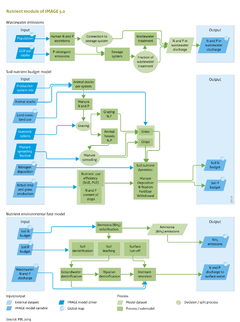Nutrients/Policy issues: Difference between revisions
Jump to navigation
Jump to search
No edit summary |
No edit summary |
||
| Line 7: | Line 7: | ||
The IMAGE soil nutrient model includes a variety of options to reduce nutrient surpluses in agriculture or nutrients in wastewater, and strategies to improve resource use efficiency. These options have been illustrated in the policy interventions and the figure below. | The IMAGE soil nutrient model includes a variety of options to reduce nutrient surpluses in agriculture or nutrients in wastewater, and strategies to improve resource use efficiency. These options have been illustrated in the policy interventions and the figure below. | ||
|Example=Extensification, increased feed efficiency and reduction in ammonia emissions from stables (cases EX, FE and ST) have minor effects on the global soil N budget. However, better integration of animal manure in crop production systems (IM), primarily in industrialised countries, and a change in the human diet with poultry replacing ruminant meat (DI), would have major effects on the global soil N budget.Other options that can be assessed, for which scenario variables originate from other IMAGE model parts, include: | |Example=Extensification, increased feed efficiency and reduction in ammonia emissions from stables (cases EX, FE and ST) have minor effects on the global soil N budget. However, better integration of animal manure in crop production systems (IM), primarily in industrialised countries, and a change in the human diet with poultry replacing ruminant meat (DI), would have major effects on the global soil N budget.Other options that can be assessed, for which scenario variables originate from other IMAGE model parts, include: | ||
* Consequences of changes in crop production systems, such as increasing crop yields, which would lead to an improvement in fertiliser use efficiency; | |||
* Consequences of changes in livestock production systems (e.g. better management leading to lower excretion rates); | |||
* Changes in the distribution of total production over mixed and pastoral systems; | |||
* Changing human diets leading to changing production volumes. | |||
}} | }} | ||
Revision as of 11:45, 8 January 2014
Parts of Nutrients/Policy issues
| Component is implemented in: |
| Components: |
| Related IMAGE components |
| Projects/Applications |
| Key publications |
